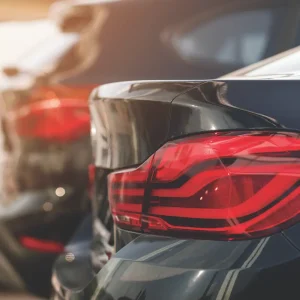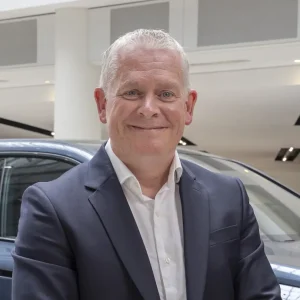In volume terms, Jaguar has always operated somewhere on the fringes of the business car market when compared with the trio of premium German manufacturers, but the desirability and appropriateness of its products isn’t really in question any more, as a pair of BusinessCar awards for the XF and XJ proved at the beginning of this year.
The issue has always been that the company has never been set up or structured to attack the business car market in the way that BMW, Audi or more recently Mercedes can.
That’s now changing, and along with sister firm Land Rover, the company has a restructured team plus a number of vital changes coming to give it a chance of significantly increasing its share of the business sector.
“During the summer I was given responsibility for all Jaguar and Land Rover corporate operations and asked to come forward with a strategy for how to address the market and keep the focus on Jaguar and on Land Rover, and the different segments of the market that need to be addressed in different ways, and bring the dealer network along with us,” Jaguar Land Rover’s UK corporate sales manager Jonathan Wackett explains. “This is the foundation work for growth. We now have a consistent structure you could argue we didn’t have before, and it’s a significant investment to address the corporate market for the long term.”
Partner brand Land Rover is further ahead, as Wackett used to look after that side of the business, and now has a corporate dealer programme in operation. However, the Jaguar version is on the way.
“We’re following the same due diligence process to ascertain the relevance of a corporate dealer programme and what it might look like,” he says. “I believe we’ll conclude we need 20-22 partner dealers to target two-24-vehicle fleets, and my expectation is that they’ll come across 25-250-vehicle fleets and they will engage our field team.” It is thought that a corporate dealer programme will be in place within six months.
The newly reorganised sales teams for Jaguar and Land Rover targeting those 25-250-vehicle fleets have been aligned, with territories for the separate brands mirroring each other for the first time so that representatives for the two marques share potential leads and opportunities.
“If they qualify customers correctly, irrespective of which brand they work for, they should understand there is an opportunity for Jaguar or Land Rover, and if they uncover an opportunity they have a responsibility to pass that on to their colleague in the other brand,” says Wackett.
This fresh focus on the corporate marketplace across JLR has come about partly because of the latest new products such as the 2.2-litre diesel Jaguar XF, Jaguar XF Sportbrake – which already takes 20% of XF sales following its launch late last year – and the Range Rover Evoque, which are a better fit for a bigger percentage of the fleet sector than what was previously on offer. Also, at the top end of the corporate market, the XJ luxury saloon now emits less than 160g/km while the new Range Rover offers 198g/km.
“I don’t think necessarily we’ve been playing catch-up,” Wackett tells BusinessCar. “We’re currently at a stage in the business development where to maximise the opportunity that exists for us in the UK as a whole, we recognise the corporate market requires a particular approach.
“Now we have a broader product offering, it’s timely and appropriate to address that corporate market in the way that would be expected from a manufacturer with the desires and aspirations Jaguar Land Rover has.”
Wackett continues: “Customers that operate in a corporate market require manufacturers to engage with them – they don’t go and find you but expect a manufacturer to knock on the door.” He also says they need manufacturers that are easy to deal with, reply to phone calls and solve problems: “The core piece of this is that we now have a long-term commitment to start to address the corporate market, not a drop-in and drop-out, and we have to provide a great customer experience and great customer service. There hasn’t been that focus, and that’s what delivers great relationships.”
Jaguar’s new fleet sales team is being led by corporate field team manager Paul Brittan, who says businesses are keen to talk. “When we’re contacting fleets, they want to see Jaguar Land Rover – they’ve maybe not seen us before,” Brittan explains to BusinessCar, claiming that appointments with fleet decision-makers are often “hijacked” by company bosses keen to find out what JLR can offer.
“We’ve largely been built on retail sales, and the Evoque and XF 2.2 have been game-changers for us, and opened up the corporate market,” he continues. “We’re only now getting into companies with competitive product.
“It seems people want to see us. There is a need for decision-makers to see Jaguar and understand what we’re about. We need to make them aware of the product and what it can offer in terms of benefit-in-kind etc., and that we’re a credible alternative now to some of the German marques that have been established long term in the market.”
Brittan says the key is establishing the brand on choice lists in order to provoke interest over the big German premium brands. “Previously, if Jaguar wasn’t on a list it wouldn’t even be considered. People stuck with what they had had for the last three years,” he says. “Now we’re established on lists, people think they might try it.”
Also important is getting people to try the vehicles. “That’s where we win, when people try the car,” Brittan continues. “We’re very proud of the way the cars drive, and the more people that get behind the wheel, the more cars we will sell.”
Given that JLR’s product range is mainly at the higher end of the market, he says there are some sectors – those with a higher ratio of senior management – the firm tends to do well in, such as electronics, aeronautical, IT and technology. “We do well with senior managers and we’re starting to get into middle managers with the XF 2.2,” Brittan adds.
He also says the dealer programme will be important, both for dealing with sub-25 business, which is the primary focus, and prospecting for larger fleets: “They know their territory intimately and have a business development manager in the dealership so they can go out and prospect the local community.”
The plan for JLR is to move from a position of pushing for new business and getting into the corporate fleets it is not currently engaging with, to managing and maintaining the contracts as the business grows. Initially, Brittan and his Land Rover counterpart Ryan Miller’s “specific remit” will be to uncover and develop the 25-250-vehicle fleets.
“At the moment we’re finding people and starting to account manage. As we mature we’ll be account managing and finding fewer people,” declares Wackett. “We’ll move from a position of trying to find them to a position of trying to look after these businesses, but you have to encourage trust and we have to demonstrate with actions what we say with words.
“We have taken a complete restructure approach to how we want to do business within the corporate market, and it’s not something we’ve plucked out of the ether – it’s rooted and has foundations,” he concludes. “I have a very clear view of how our business should interface with the corporate market and I am committed to delivering that over the next five years or so.”
New models, technology and cleaner engines
Jaguar Land Rover has put its new corporate focus in place now because it has what it describes as 40 “product actions” coming over the next five years. Starting with the new F-type in April, the product actions cover new engines, new models, range developments and facelifts.
A key one from a business car perspective is the £355m investment in a new engine plant near Wolverhampton that will produce four-cylinder petrol and diesel engines. Although it’s not confirmed which models the new units will appear in or from when, the smaller-capacity engines will offer reduced emissions and increased efficiency compared with the current options, which don’t go below the 2.2-litre diesel used in the Jaguar XF, Land Rover Freelander and Range Rover Evoque.
JLR is also making investments in developing lightweight aluminium technology, with the intrinsic link between weight and emissions meaning the latter should come down in the future. The target is a 10% reduction across JLR by 2015, on top of the 15% it says it has achieved since 2007.
While the majority of the 40 new product actions are as yet shrouded in secrecy, they will include various applications of the new engines, plus replacements for most of the current JLR line-up over the next five years, with a new Range Rover Sport expected late this year, plus the exciting new Jaguar F-type sports car revealed at the Paris motor show last year and due to go on sale in the UK next month. The two-seat convertible starts at £58,500 for the 340hp 3.0-litre petrol version, and goes up to £79,950 for the 495hp 5.0-lite V8. “I’m sure I can sell a few to the corporate market, chief executive and business owners,” says Jaguar UK corporate field team manager Paul Brittan.





